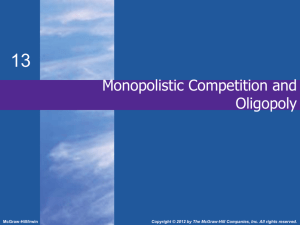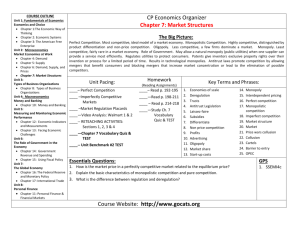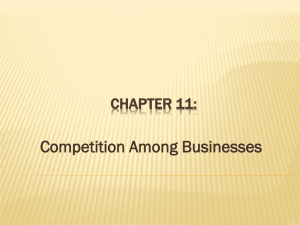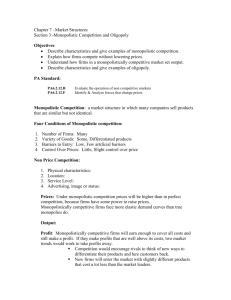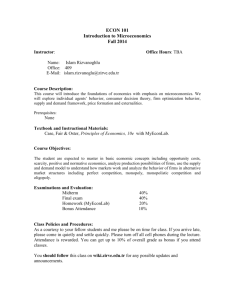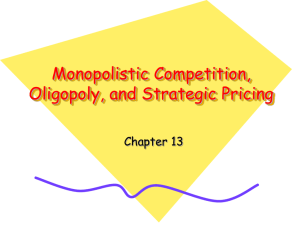Monopolistic Competition & Oligopoly
advertisement
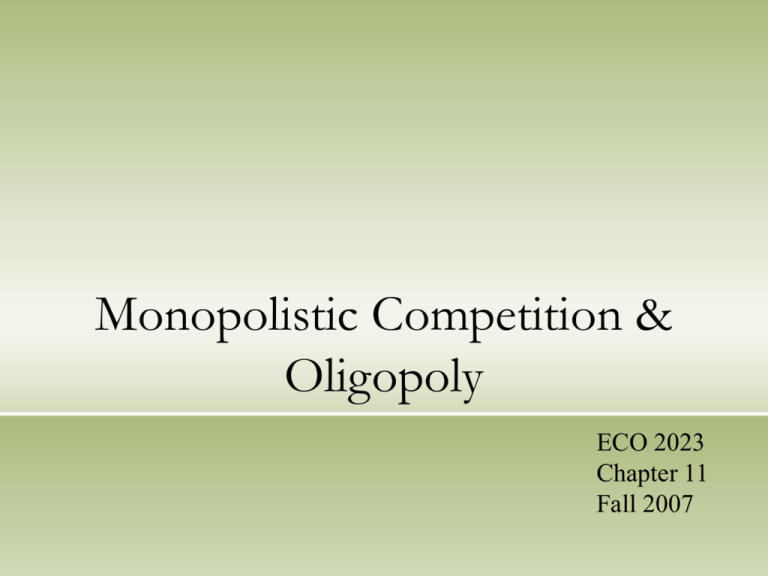
Monopolistic Competition & Oligopoly ECO 2023 Chapter 11 Fall 2007 Monopolistic Competition • A market structure with many firms selling products that are substitutes but different enough that each firm’s demand curve slopes downward, firm entry is relatively easy Characteristics • • • • • • Relatively large number of sellers Differentiated product Ease of entry and exit Low barriers to entry Price makers Advertising Monopolistic Competition • Product Differentiation • Physical differences • Differences in appearance and qualities • Evian vs Dasani • Location • The number and variety of locations where a product is available are other ways • Services • Product image Monopolistic Competition • Short-run Profit Maximization • Because each monopolistic competitor offers a product that differs somewhat from what others supply • Each has some control over the price charged • Demand curve slopes downward • Elastic demand • Marginal revenue = marginal cost Monopolistic Competition – Short run Price Profit Marginal Cost Average Total Cost Price Profit Cost Demand Marginal Revenue Q Monopolistic Competition – Short run Price Cost Price Loss Marginal Cost Average Total Cost Loss Demand Marginal Revenue Q Long run Economic Profit • If short run has economic profit • • • • Firms enter the industry Output increases Price decreases Profit in long run disappears • If short run economic loss • • • • Firms exit the industry Output decreases Price increases Loss disappears Long run No economic Profits or Losses Oligopoly • Market structure characterized by a few firms whose behavior is interdependent Characteristics • • • • A few large producers Homogeneous or differentiated products Control over Price Mutual interdependence and strategic behavior • Barriers to entry • Mergers Mergers • Oligopolists have a tendency to merge and become monopolists • Increases market share • Greater economies of scale • Caused by desire for monopoly power Measures of Industry Concentration • oligopolistic industries are concentrated in the hands of their largest firms • Concentration ratios • Reveals the percentage of total output produced and sold by an industry’s largest firms. • When largest four firms control over 40% then it is oligopoly • Automotive 81% • Sugar cane 99% • Shortcomings • Localized markets • Interindustry competition • World trade • Herfindahl Index • The index is the sum of squared percentage market shares of all firms in the industry. • Larger the index, the more market power within the industry Oligopoly • Models of Oligopoly • There is no general theory but rather a set of theories • Each based on the diversity of observed behavior in an interdependent market • Collusion • an agreement among firms to increase economic profit by dividing the market or fixing the price • CARTELS are created Oligopoly • Collusion • Cartel • A group of firms that agree to coordinate their production and pricing decisions to act like a monopolist • Problems with Collusion and Cartels • Differences in Average Cost • Number of firms in the cartel • New entry into the industry Oligopoly • Price Leadership • A firm whose price is adopted by other firms in the industry • Tacit form of collusion • Typically a dominant firm in the industry • Set prices and others follow avoiding competition • Violates antitrust laws Oligopoly • Game Theory • An approach that analyzes ologopolistic behavior as a series of strategic moves and countermoves by rival firms • Outcome is achieved when each player’s choice does not depend on what the other player does





